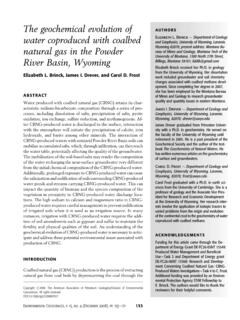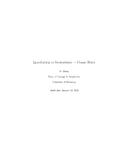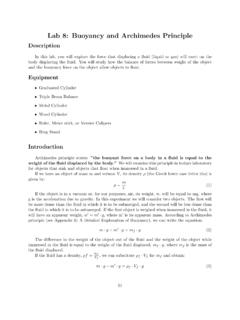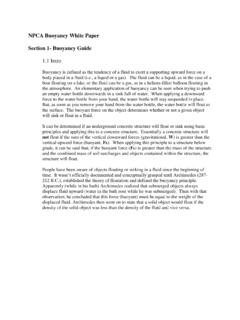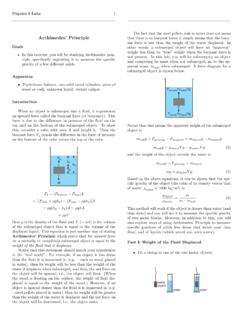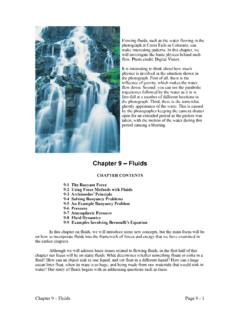Transcription of Introduction to Geophysics: Buoyancy Lab Name
1 1 Introduction to geophysics : Buoyancy Lab Name_____ Assume a block of height h (m) and density b (kg/m3) is placed into a fluid of density f. Please use MKS units throughout this lab. Note that we are doing a 1-dimensional problem in a 3-dimensional world which means that the length and width of the block can be assume to be unity (1) and thus this dimensions are irrelevant to our calculation. Correspondinly, the forces calculated will be force per unit area (m2) which is pressure (1 Newton/m2 == 1 Pascal). 1. (1 pt) State a clear and accurate definition of archimedes Principle. 2. (1 pt) What physical condition is required for the block to float. 3. (1 pt) What physical condition is required for the block to sink. 4. (1 pt) What physical condition is required for the block to remain where it is placed. 5. (2 pt) State the formula for the force of gravity per unit area (Fg) on the block using the variables we have defined.
2 Assume g= m/s2 and the height of the block (h) is 10 m. State the units of the gravitational force on the block. 6. (2 pt) Assume the block is floating and that the block height above the liquid surface is h1 and the block height submerged below the liquid surface is h2. Hence, the total height of the block is defined as: h = h1 + h2. State the formula for the Buoyancy force per unit area (Fb) on the block using archimedes Principle and the variables we have defined. Do a dimensional analysis to show the units are equal on either side of the equality sign. 7. (1 pt) In terms of the two forces (gravity (weight) and Buoyancy forces) acting on the block, state what it means for the block to be in static mechanical equilibrium. Draw a vector diagram of the two forces acting on the block. 28. (1 pt) State how a static mechanical equilibrium relates to Newton s second law formula.
3 Label the units and meaning of the second law formula. 9. (5 pt) Assume that an ice block is floating in water because b < f ( b = kg/m3; f = kg/m3) and that the block is in static mechanical equilibrium. Assume that the block height (h) is 10 m. Define the block height above the liquid surface as h1 and the block height submerged below the liquid surface as h2. Hence, the total height of the block is: h = h1 + h2. Using the defined variables derive a formula for h1 and h2. Then, solve for the percentage of the ice block s height that is above the liquid-water surface (hint: calculate ratio of above to below water height (h1/h2)*100). 310. (Extra credit: 3 pts) Derive a function for pressure as a function of depth in a fluid assuming that g(z) and (z) are constants. Call the function P(z) where P is pressure and z is depth below the liquid surface.
4 Assume that the atmospheric pressure at the liquid surface is 100,000 Pascal. (hint: do a definite integral from depth 0 to z). Buoyancy Force. An upward force exerted by a fluid on any body (object/block/etc) immersed in it. Buoyant force can be explained in terms of archimedes ' arises from the fact that fluid pressure increases with depth and from the fact that the increased pressure is exerted in all directions (Pascal's principle) so that there is an unbalanced upward force on the bottom of a submerged object. archimedes ' principle. The principle that states that a body immersed in a fluid is buoyed up by a force equal to the weight of the displaced fluid. The principle applies to both floating and submerged bodies and to all fluids, , liquids and gases. It explains not only the Buoyancy of ships and other vessels in water but also the rise of a balloon in the air and the apparent loss of weight of objects underwater.
5 archimedes ' principle: buoyant force on an object = weight of the fluid displaced by the object. Since the "water ball" at left is exactly supported by the difference in pressure and the solid object at right experiences exactly the same pressure environment, it follows that the buoyant force on the solid object is equal to the weight of the water displaced ( archimedes ' principle) BECAUSE the water ball is in static equilibrium where the water ball weight (downward force) is balanced by the upward Buoyancy force so that Fnet = 0, hence there is not acceleration of the water ball. Pressure. Pressure is defined as force per unit area. It is usually more convenient to use pressure rather than force to describe the influences upon fluid behavior. The standard unit for pressure is the Pascal, which is a Newton per square meter. For an object sitting on a surface, the force pressing on the surface is the weight of the object, but in different orientations it might have a different area in contact with the surface and therefore exert a different pressure.
6 Pascal's Principle or Law. Pressure is transmitted undiminished in an enclosed static fluid. A force applied to one section of an enclosed liquid at rest will be transferred to the entire liquid with the same amount of force. This is why a hydraulic jack works and you can blow out the bottom of a bottle by pushing on its top. Extra credit (3 pts): For the hydraulic jack in the right diagram above, if F1 force is applied over a distance d1 , what is the displacement of the A2 area? Why does a hydraulic jack produce a mechanical advantage like a lever arm? 4
